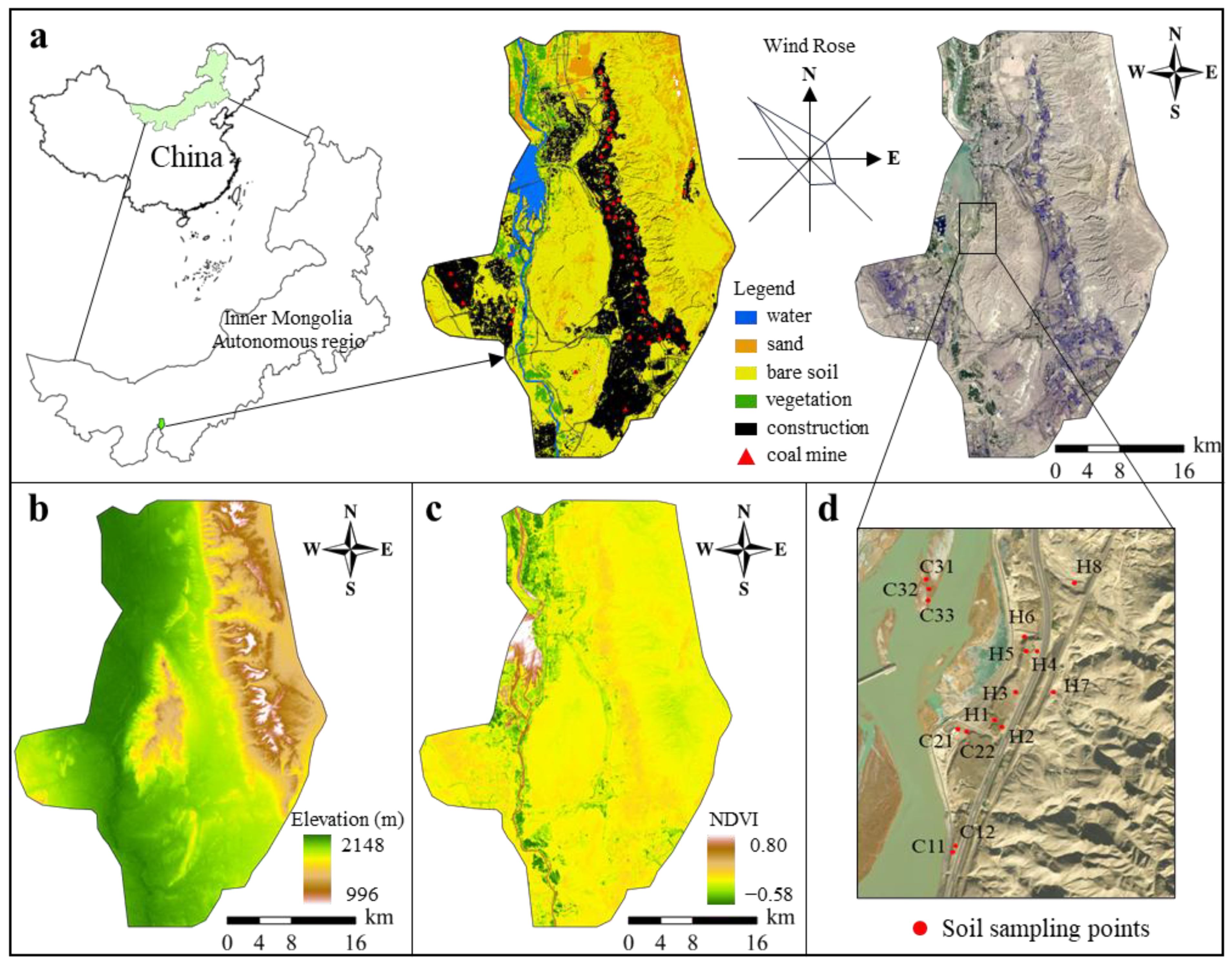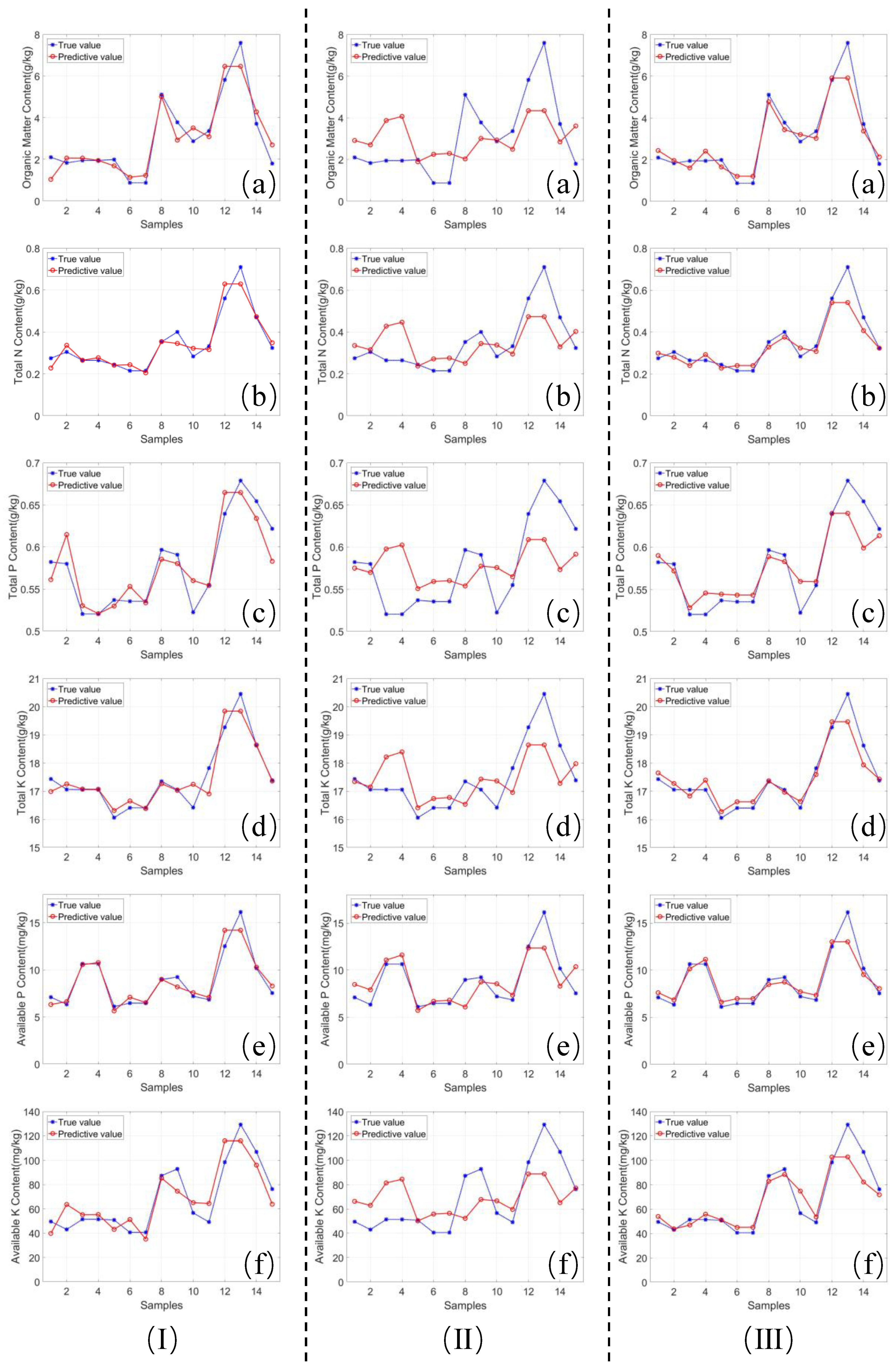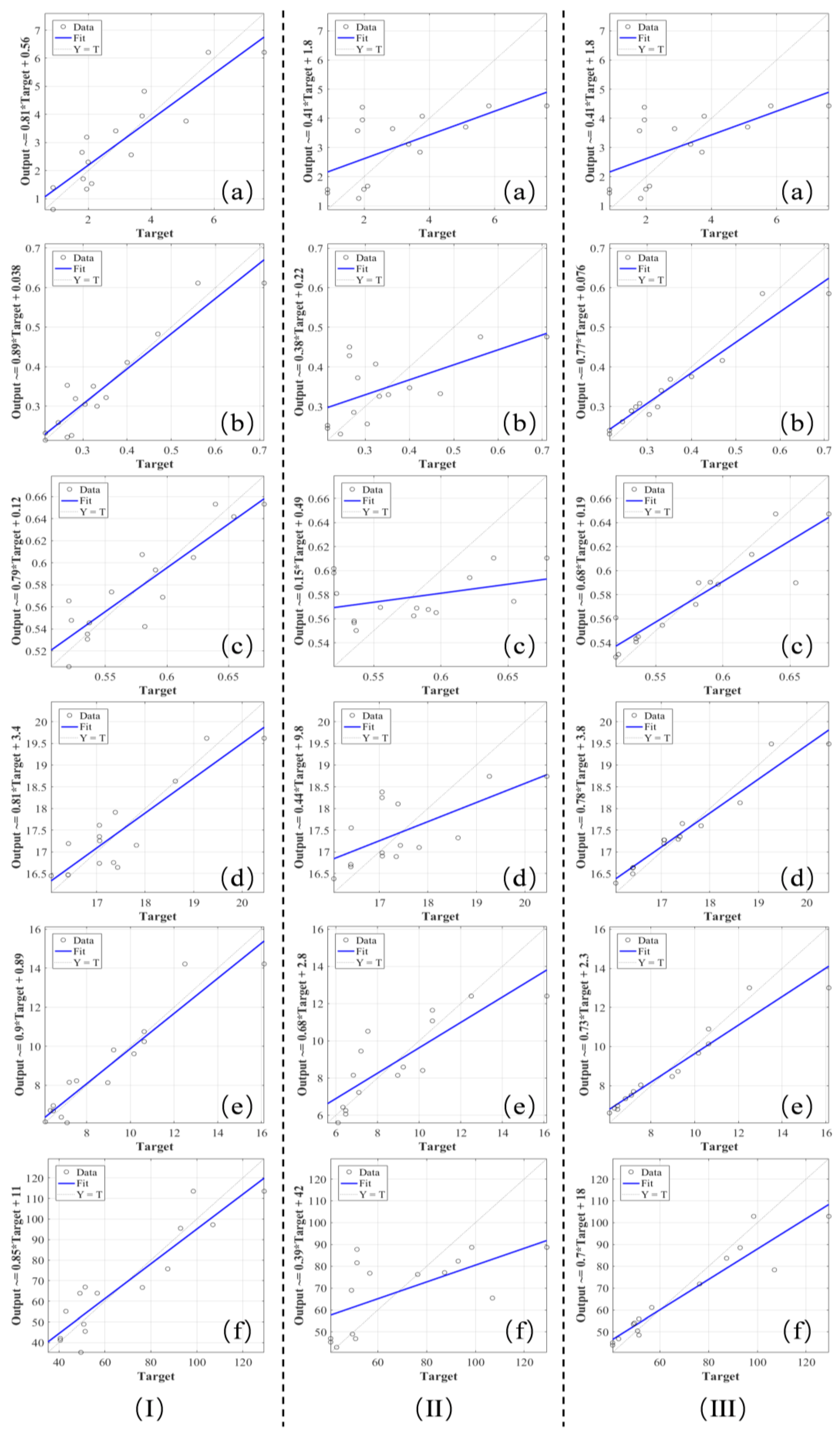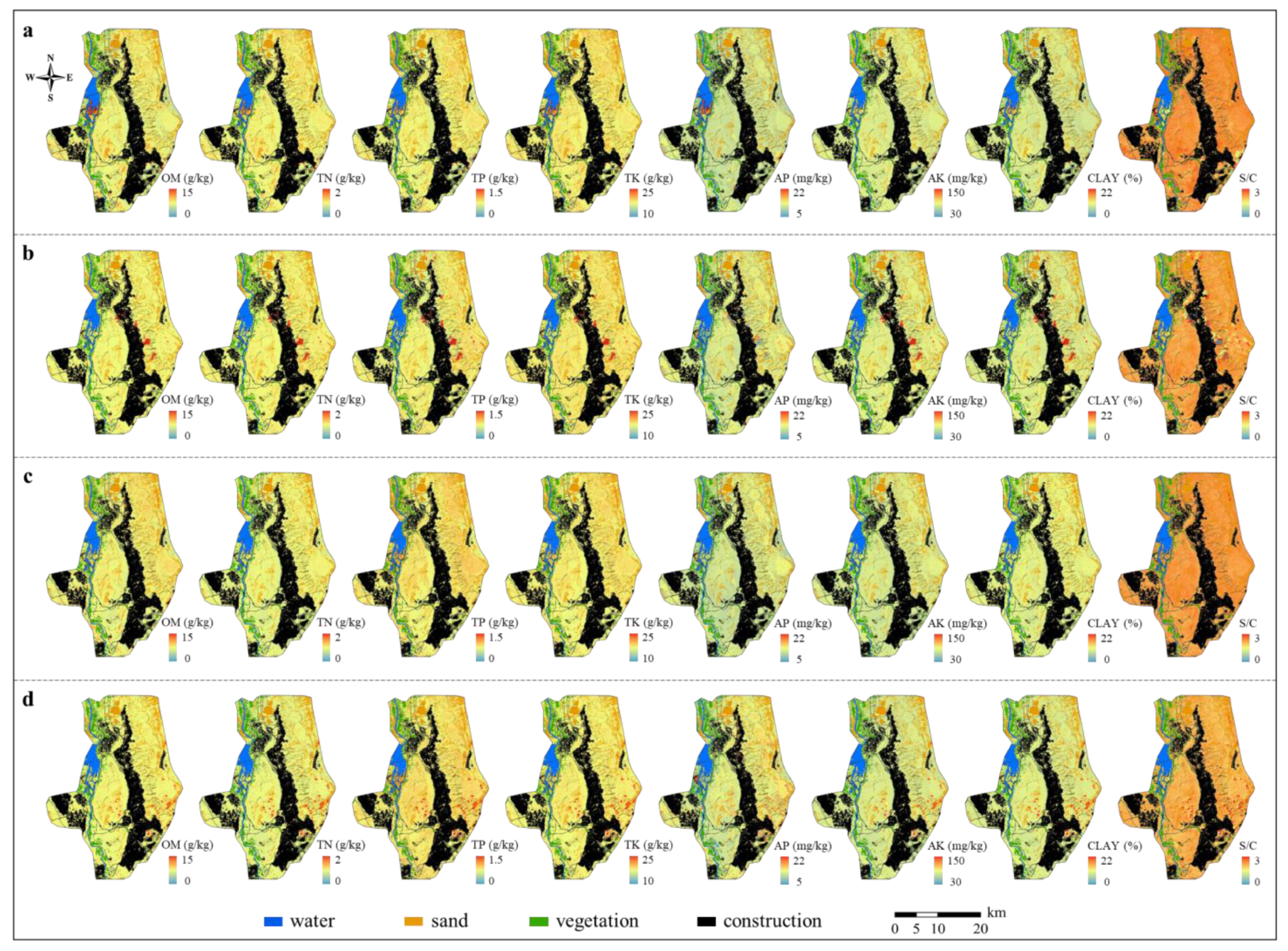Multispectral Remote Sensing Monitoring Methods for Soil Fertility Assessment and Spatiotemporal Variation Characteristics in Arid and Semi-Arid Mining Areas
Abstract
1. Introduction
2. Data and Methods
2.1. Experimental Scheme
2.2. Overview of the Study Area
2.3. Soil Sampling and Analysis of Various Indicators
2.4. Remote Sensing Image Data Selection, Processing, and Analysis
2.4.1. Image Selection and Preprocessing
2.4.2. Calculation of Surface Reflectivity
2.5. Modeling Methods and Accuracy Evaluation
2.6. Comprehensive Evaluation of Soil Fertility
2.6.1. Constructing Membership Functions
2.6.2. Determine the Weight of Each Soil Indicator
2.6.3. Soil Fertility Evaluation
3. Results and Analysis
3.1. Establishment and Validation of Soil Nutrient Prediction Model
3.2. The Inversion of Various Soil Indicators
3.3. Comprehensive Evaluation of Soil Fertility
3.4. Spatiotemporal Variation Characteristics of Soil Fertility
4. Discussion
4.1. The Effectiveness of Predicting the Spatial Distribution of Soil Fertility Using Surface Spectral Reflectance Data
4.2. Applicability and Limitations
5. Conclusions
- (1)
- The 6SV-SVM prediction model for surface soil indicators developed using Landsat 8 OLI imagery achieved high prediction accuracy (R2 > 0.85) for six soil nutrient contents in the study area. This study established the first rapid assessment method for comprehensive surface soil fertility based on multispectral remote sensing monitoring, effectively addressing the limitations of single-indicator inversion approaches.
- (2)
- The methodology successfully enabled long-term sequential evaluation of individual soil indicators and spatial distribution patterns of comprehensive soil fertility. This provides a scientific basis for monitoring spatiotemporal variations in soil quality across undulating arid and semi-arid terrains, offering a practical solution for long-term soil quality monitoring.
- (3)
- Future research could further analyze soil fertility dynamics in heterogeneous landscapes under varying disturbance gradients (e.g., mining intensity, vegetation recovery stages, soil erosion levels) in arid mining areas. Quantitative investigation of the relationship between soil fertility evolution and mining lifecycle phases (exploration → extraction → closure) holds significant research potential for understanding soil fertility change patterns and optimizing regional soil ecological conservation strategies.
Author Contributions
Funding
Data Availability Statement
Acknowledgments
Conflicts of Interest
References
- Li, Q.; Hu, Z.; Zhang, F.; Song, D.; Liang, Y.; Yu, Y. Multispectral Remote Sensing Monitoring of Soil Particle-Size Distribution in Arid and Semi-Arid Mining Areas in the Middle and Upper Reaches of the Yellow River Basin: A Case Study of Wuhai City, Inner Mongolia Autonomous Region. Remote Sens. 2023, 15, 2137. [Google Scholar] [CrossRef]
- Li, H.; Jiang, X. Spatiotemporal characteristics of soil nutrients and fertility valuation of agricultural land in the Huang-Huai-Hai Plain agricultural area: A case study of Boxing County, Shandong Province. J. Agric. Resour. Environ. 2022, 39, 602–612. [Google Scholar] [CrossRef]
- Xu, J.; Zhang, G. Indices and Assessment of Soil Quality; Science Press: Beijing, China, 2010. [Google Scholar]
- Bi, Y.L.; Peng, S.P.; Du, S.Z. Technological difficulties and future directions of ecological reconstruction in open pit coal mine of the arid and semi-arid areas of Western China. J. China Coal Soc. 2021, 46, 1355–1364. [Google Scholar] [CrossRef]
- Han, J.Z.; Hu, Z.Q.; Wang, P.J.; Yan, Z.G.; Li, G.S.; Zhang, Y.H.; Zhou, T. Spatio-temporal evolution and optimization analysis of ecosystem service value—A case study of coal resource-based city group in Shandong, China. J. Clean. Prod. 2022, 363, 12. [Google Scholar] [CrossRef]
- Hu, Z.Q.; Zhao, Y.L. Main problems in ecological restoration of mines and their solutions. China Coal 2021, 47, 2–7. [Google Scholar] [CrossRef]
- Hu, Z.Q.; Zhao, Y.L. Principle and technology of coordinated control of eco-environment of mining areas and river sediments in Yellow River watershed. J. China Coal Soc. 2022, 47, 438–448. [Google Scholar] [CrossRef]
- Xi, J.P. Speech at the symposium on ecological protection and high-quality development in the Yellow River basin. Water Conserv. Constr. Manag. 2019, 39, 1–3+6. [Google Scholar] [CrossRef]
- Clark, R.N.; Roush, T.L. Reflectance spectroscopy: Quantitative analysis techniques for remote sensing applications. J. Geophys. Res. Solid Earth 1984, 89, 6329–6340. [Google Scholar] [CrossRef]
- Domínguez-Haydar, Y.; Velásquez, E.; Carmona, J.; Lavelle, P.; Chavez, L.F.; Jiménez, J.J. Evaluation of reclamation success in an open-pit coal mine using integrated soil physical, chemical and biological quality indicators. Ecol. Indic. 2019, 103, 182–193. [Google Scholar] [CrossRef]
- Bao, N.S.; Liu, S.J.; Zhou, Y.C. Predicting particle-size distribution using thermal infrared spectroscopy from reclaimed mine land in the semi-arid grassland of North China. Catena 2019, 183, 104190. [Google Scholar] [CrossRef]
- Madari, B.E.; Reeves, J.B.; Machado, P.; Guimaraes, C.M.; Torres, E.; McCarty, G.W. Mid- and near-infrared spectroscopic assessment of soil compositional parameters and structural indices in two Ferralsols. Geoderma 2006, 136, 245–259. [Google Scholar] [CrossRef]
- Ben-Dor, E.; Chabrillat, S.; Demattê, J.A.M.; Taylor, G.R.; Hill, J.; Whiting, M.L.; Sommer, S. Using Imaging Spectroscopy to study soil properties. Remote Sens. Environ. 2009, 113, S38–S55. [Google Scholar] [CrossRef]
- Fongaro, C.T.; Demattê, J.A.M.; Rizzo, R.; Lucas Safanelli, J.; Mendes, W.D.; Dotto, A.C.; Vicente, L.E.; Franceschini, M.H.D.; Ustin, S.L. Improvement of Clay and Sand Quantification Based on a Novel Approach with a Focus on Multispectral Satellite Images. Remote Sens. 2018, 10, 1555. [Google Scholar] [CrossRef]
- Shi, P.; Six, J.; Sila, A.; Vanlauwe, B.; Van Oost, K. Towards spatially continuous mapping of soil organic carbon in croplands using multitemporal Sentinel-2 remote sensing. ISPRS J. Photogramm. Remote Sens. 2022, 193, 187–199. [Google Scholar] [CrossRef]
- Wang, S.; Guan, K.; Zhang, C.; Lee, D.; Margenot, A.J.; Ge, Y.; Peng, J.; Zhou, W.; Zhou, Q.; Huang, Y. Using soil library hyperspectral reflectance and machine learning to predict soil organic carbon: Assessing potential of airborne and spaceborne optical soil sensing. Remote Sens. Environ. 2022, 271, 112914. [Google Scholar] [CrossRef]
- Xiao, J.; Shen, Y.; Tateishi, R.; Bayaer, W. Development of topsoil grain size index for monitoring desertification in arid land using remote sensing. Int. J. Remote Sens. 2007, 27, 2411–2422. [Google Scholar] [CrossRef]
- Duan, D.D.; Sun, X.; Liang, S.F.; Sun, J.; Fan, L.L.; Chen, H.; Xia, L.; Zhao, F.; Yang, W.Q.; Yang, P. Spatiotemporal Patterns of Cultivated Land Quality Integrated with Multi-Source Remote Sensing: A Case Study of Guangzhou, China. Remote Sens. 2022, 14, 1250. [Google Scholar] [CrossRef]
- Kumar, D.; Rizvi, R.H.; Bhatt, S.; Singh, R.; Chaturvedi, O.P. Land use/land cover change and soil fertility mapping using GIS and remote sensing: A case study of Parasai-Sindh watershed in Bundelkhand region of central India. Range Manag. Agrofor. 2021, 42, 15–21. [Google Scholar]
- Qv, W.; Du, H.; Wang, X. Remote Sensing Inversion of Soil Organic Matter Content in Straw-Returned Fields in China’s Black Soil Region. Sustainability 2024, 16, 7058. [Google Scholar] [CrossRef]
- Chen, F.; Kissel, D.E.; West, L.T.; Adkins, W.; Rickman, D.; Luvall, J.C. Mapping soil organic carbon concentration for multiple fields with image similarity analysis. Soil Sci. Soc. Am. J. 2008, 72, 186–193. [Google Scholar] [CrossRef]
- D’Acqui, L.P.; Pucci, A.; Janik, L.J. Soil properties prediction of western Mediterranean islands with similar climatic environments by means of mid-infrared diffuse reflectance spectroscopy. Eur. J. Soil Sci. 2010, 61, 865–876. [Google Scholar] [CrossRef]
- Levi, N.; Karnieli, A.; Paz-Kagan, T. Airborne imaging spectroscopy for assessing land-use effect on soil quality in drylands. ISPRS J. Photogramm. Remote Sens. 2022, 186, 34–54. [Google Scholar] [CrossRef]
- McCarty, G.W.; Reeves, J.B.; Reeves, V.B.; Follett, R.F.; Kimble, J.M. Mid-infrared and near-infrared diffuse reflectance spectroscopy for soil carbon measurement. Soil Sci. Soc. Am. J. 2002, 66, 640–646. [Google Scholar] [CrossRef]
- Shoshany, M.; Roitberg, E.; Goldshleger, N.; Kizel, F. Universal quadratic soil spectral reflectance line and its deviation patterns’ relationships with chemical and textural properties: A global data base analysis. Remote Sens. Environ. 2022, 280, 113182. [Google Scholar] [CrossRef]
- Zolfaghari, A.A.; Toularoud, A.A.S.; Baghi, F.; Mirzaee, S. Spatial prediction of soil particle size distribution in arid agricultural lands in central Iran. Arab. J. Geosci. 2022, 15, 1574. [Google Scholar] [CrossRef]
- Zhao, X.; Xu, Z.J.; Yin, J.P.; Bi, R.T.; Feng, J.F.; Liu, P. Retrieval of Soil Organic Carbon in Cinnamon Mining Belt Subsidence Area Based on OLI and 6SV. Spectrosc. Spect. Anal. 2019, 39, 886–893. [Google Scholar]
- Luo, C.; Zhang, W.; Zhang, X.; Liu, H. Mapping the soil organic matter content in a typical black-soil area using optical data, radar data and environmental covariates. Soil Tillage Res. 2024, 235, 105912. [Google Scholar] [CrossRef]
- Aksoy, S.; Yildirim, A.; Gorji, T.; Hamzehpour, N.; Tanik, A.; Sertel, E. Assessing the performance of machine learning algorithms for soil salinity mapping in Google Earth Engine platform using Sentinel-2A and Landsat-8 OLI data. Adv. Space Res. 2022, 69, 1072–1086. [Google Scholar] [CrossRef]
- Castaldi, F.; Hueni, A.; Chabrillat, S.; Ward, K.; Buttafuoco, G.; Bomans, B.; Vreys, K.; Brell, M.; van Wesemael, B. Evaluating the capability of the Sentinel 2 data for soil organic carbon prediction in croplands. ISPRS J. Photogramm. Remote Sens. 2019, 147, 267–282. [Google Scholar] [CrossRef]
- Castaldi, F.; Palombo, A.; Santini, F.; Pascucci, S.; Pignatti, S.; Casa, R. Evaluation of the potential of the current and forthcoming multispectral and hyperspectral imagers to estimate soil texture and organic carbon. Remote Sens. Environ. 2016, 179, 54–65. [Google Scholar] [CrossRef]
- Zhou, T.; Geng, Y.; Chen, J.; Pan, J.; Haase, D.; Lausch, A. High-resolution digital mapping of soil organic carbon and soil total nitrogen using DEM derivatives, Sentinel-1 and Sentinel-2 data based on machine learning algorithms. Sci. Total Environ. 2020, 729, 138244. [Google Scholar] [CrossRef]
- Chang, R.C.; Chen, Z.; Wang, D.M.; Guo, K. Hyperspectral Remote Sensing Inversion and Monitoring of Organic Matter in Black Soil Based on Dynamic Fitness Inertia Weight Particle Swarm Optimization Neural Network. Remote Sens. 2022, 14, 4316. [Google Scholar] [CrossRef]
- Dobarco, M.R.; Arrouays, D.; Lagacherie, P.; Ciampalini, R.; Saby, N.P.A. Prediction of topsoil texture for Region Centre (France) applying model ensemble methods. Geoderma 2017, 298, 67–77. [Google Scholar] [CrossRef]
- Dou, X.; Wang, X.; Liu, H.J.; Zhang, X.L.; Meng, L.H.; Pan, Y.; Yu, Z.Y.; Cui, Y. Prediction of soil organic matter using multi-temporal satellite images in the Songnen Plain, China. Geoderma 2019, 356, 113896. [Google Scholar] [CrossRef]
- Gulnara, K.; Kazbek, B.; Gulzhiyan, K.; Aidyn, A.; Linara, A. Use of the Earth Remote Sensing data for the monitoring of the level of soil fertility. In Proceedings of the 8th International Conference on Remote Sensing and Geoinformation of the Environment (RSCy), Paphos, Cyprus, 16–18 March 2020. [Google Scholar]
- Li, Y.S.; Chang, C.Y.; Wang, Z.R.; Li, T.; Li, J.W.; Zhao, G.X. Identification of Cultivated Land Quality Grade Using Fused Multi-Source Data and Multi-Temporal Crop Remote Sensing Information. Remote Sens. 2022, 14, 2109. [Google Scholar] [CrossRef]
- Liu, C.; Sun, Q.; Zhang, C.; Chen, W.T.; Qu, X.Z.; Tang, B.Y.; Ma, K.; Gu, X.H. Monitoring the interannual dynamic changes of soil organic matter using long-term Landsat images. Precis. Agric. 2025, 26, 50. [Google Scholar] [CrossRef]
- Liu, X.; Wang, M.; Liu, Z.; Bao, Y.; Li, X.; Wang, F.; Ji, X. Improving spatial prediction of soil organic matter in typical black soil area of Northeast China using structural equation modeling integration framework. Comput. Electron. Agric. 2025, 236, 110404. [Google Scholar] [CrossRef]
- Talukder, A.; Raghavendra, C.; Glenn, E.; Soc, I.C. AI-based Soil Fertility Quality Estimation from Remote Sensing Data. In Proceedings of the 30th International Conference on High Performance Computing, Data, and Analytics (HiPC), Goa, India, 18–21 December 2023; p. 70. [Google Scholar]
- Zhang, L. Research on Reservoir Water Depth Inversion and Water Area Extraction Based on Multi-Band Remote Sensing. Master’s Thesis, Inner Mongolia Agricultural University, Hohhot, China, 2018. [Google Scholar]
- Vermote, E.; Justice, C.; Claverie, M.; Franch, B. Preliminary analysis of the performance of the Landsat 8/OLI land surface reflectance product. Remote Sens. Environ. 2016, 185, 46–56. [Google Scholar] [CrossRef]







| Sampling Point | Soil Thickness (cm) | Average Content of Soil Nutrients | |||||
|---|---|---|---|---|---|---|---|
| Organic Matter (g/kg) | Total N (g/kg) | Total P (g/kg) | Total K (g/kg) | Available P (mg/kg) | Available K (mg/kg) | ||
| C | 0–20 | 1.975 | 0.251 | 0.562 | 16.971 | 7.000 | 50.958 |
| 0–40 | 1.719 | 0.250 | 0.550 | 16.816 | 7.350 | 47.859 | |
| 0–60 | 1.654 | 0.255 | 0.544 | 16.783 | 7.676 | 46.801 | |
| H | 0–20 | 4.296 | 0.426 | 0.601 | 18.180 | 9.850 | 73.136 |
| 0–40 | 4.499 | 0.451 | 0.607 | 18.165 | 9.956 | 81.567 | |
| 0–60 | 4.257 | 0.429 | 0.607 | 18.047 | 9.821 | 87.139 | |
| Band | Signal-to-Noise Ratio | ||
|---|---|---|---|
| 1—COASTAL/AEROSOL | 0.43–0.45 | 130 | 30 |
| 2—Blue | 0.45–0.51 | 130 | 30 |
| 3—Green | 0.53–0.59 | 100 | 30 |
| 4—Red | 0.64–0.67 | 90 | 30 |
| 5—NIR | 0.85–0.88 | 90 | 30 |
| 6—SWIR1 | 1.57–1.65 | 100 | 30 |
| 7—SWIR2 | 2.11–2.29 | 100 | 30 |
| 8—PAN | 0.50–0.68 | 80 | 15 |
| 9—Cirrus | 1.36–1.38 | 50 | 30 |
| Index | ||||
|---|---|---|---|---|
| Organic Matter (g/kg) | 10 | 20 | - | - |
| Total N (g/kg) | 0.5 | 1 | - | - |
| Total P (g/kg) | 0.2 | 0.5 | - | - |
| Total K (g/kg) | 10 | 20 | - | - |
| Available P (mg/kg) | 3 | 10 | - | - |
| Available K (mg/kg) | 50 | 100 | - | - |
| Clay | 20 | 40 | 60 | 80 |
| S/C | 0.5 | 1.5 | 2.5 | 3.5 |
| IFI | Soil Fertility Grading | The Level of Soil Fertility |
|---|---|---|
| ≥0.70 | I | High |
| 0.55–0.70 | II | Higher |
| 0.40–0.55 | III | Medium |
| 0.25–0.40 | IV | Lower |
| ≤0.25 | V | Low |
| Model | (Nutrient’s Content) | ||||||||
|---|---|---|---|---|---|---|---|---|---|
| 6SV-MLR | (Organic Matter) | 7.93 | 1.99 | −2.77 | −1.67 | 1.13 | 0.43 | −1.34 | 1.56 |
| (Total N) | 1.04 | 0.03 | −0.01 | −0.27 | 0.14 | 0.04 | −0.13 | 0.13 | |
| (Total P) | 0.96 | −0.07 | 0.09 | −0.10 | 0.05 | 0.01 | −0.06 | 0.06 | |
| (Total K) | 22.52 | −0.20 | 0.49 | −2.14 | 1.08 | 0.21 | −0.84 | 0.91 | |
| (Available P) | 8.72 | 1.44 | 0.50 | −4.90 | 2.34 | 1.15 | −1.93 | 1.70 | |
| (Available K) | 213.74 | −6.45 | 16.23 | −60.05 | 27.96 | 8.92 | −26.92 | 26.76 | |
| 6SV-PLSR | (Organic Matter) | −2.39 | −0.14 | −0.07 | 0.003 | 0.016 | 0.15 | 0.06 | 0.05 |
| (Total N) | −0.055 | −0.005 | −0.001 | 0.002 | 0.002 | 0.008 | 0.004 | 0.003 | |
| (Total P) | 0.486 | −0.0002 | 0.0002 | 0.0007 | 0.0006 | 0.0014 | 0.0009 | 0.0007 | |
| (Total K) | 13.92 | −0.005 | 0.013 | 0.029 | 0.024 | 0.052 | 0.033 | 0.028 | |
| (Available P) | −2.21 | −0.11 | −0.02 | 0.06 | 0.06 | 0.21 | 0.11 | 0.09 | |
| (Available K) | −10.38 | −1.99 | −0.99 | 0.07 | 0.24 | 2.15 | 0.90 | 0.72 |
| Atmospheric Correction Model | Model | Evaluation Index | Soil Nutrient Types | |||||
|---|---|---|---|---|---|---|---|---|
| Organic Matter | Total N | Total P | Total K | Available P | Available K | |||
| 6SV | MLR | R2 | 0.815 | 0.891 | 0.795 | 0.806 | 0.899 | 0.846 |
| F | 4.396 | 8.149 | 3.877 | 4.144 | 8.945 | 5.480 | ||
| PLSR | R2 | 0.407 | 0.378 | 0.150 | 0.441 | 0.682 | 0.385 | |
| SVM | R2 | 0.956 | 0.936 | 0.877 | 0.946 | 0.926 | 0.897 | |
| MSE | 0.005 | 0.007 | 0.020 | 0.006 | 0.009 | 0.015 | ||
| Year | Soil Index | Min | Max | Average | Standard Deviation | K-S Test | Distribution Type |
|---|---|---|---|---|---|---|---|
| 2015 | OM (g/kg) | 0.88 | 10.36 | 4.84 | 2.12 | 0.20 | Normal Distribution |
| TN (g/kg) | 0.18 | 1.36 | 0.49 | 0.36 | 0.21 | Normal Distribution | |
| TP (g/kg) | 0.25 | 0.86 | 0.58 | 0.43 | 0.18 | Normal Distribution | |
| TK (g/kg) | 13.19 | 22.65 | 17.48 | 7.89 | 0.22 | Normal Distribution | |
| AP (mg/kg) | 5.01 | 19.87 | 9.63 | 7.17 | <0.05 | Lognormal Distribution | |
| AK (mg/kg) | 36.98 | 139.28 | 84.36 | 75.69 | 0.15 | Normal Distribution | |
| Clay | 0.61 | 15.73 | 9.98 | 8.13 | <0.05 | Lognormal Distribution | |
| S/C | 0.14 | 2.78 | 1.69 | 1.51 | 0.16 | Normal Distribution | |
| 2018 | OM (g/kg) | 0.97 | 9.59 | 5.16 | 4.27 | 0.22 | Normal Distribution |
| TN (g/kg) | 0.19 | 1.41 | 0.45 | 0.41 | <0.05 | Lognormal Distribution | |
| TP (g/kg) | 0.27 | 0.95 | 0.61 | 0.47 | 0.21 | Normal Distribution | |
| TK (g/kg) | 12.27 | 23.17 | 18.31 | 14.82 | 0.19 | Normal Distribution | |
| AP (mg/kg) | 4.08 | 18.15 | 9.96 | 9.87 | <0.05 | Lognormal Distribution | |
| AK (mg/kg) | 37.25 | 141.58 | 86.75 | 81.31 | 0.17 | Normal Distribution | |
| Clay | 0.47 | 18.47 | 10.11 | 9.64 | <0.05 | Lognormal Distribution | |
| S/C | 0.12 | 2.77 | 1.61 | 1.54 | 0.25 | Normal Distribution | |
| 2021 | OM (g/kg) | 1.02 | 10.94 | 5.54 | 3.97 | <0.05 | Lognormal Distribution |
| TN (g/kg) | 0.09 | 1.96 | 0.43 | 0.19 | 0.20 | Normal Distribution | |
| TP (g/kg) | 0.10 | 0.91 | 0.60 | 0.27 | 0.14 | Normal Distribution | |
| TK (g/kg) | 13.4 | 22.98 | 18.08 | 10.81 | 0.20 | Normal Distribution | |
| AP (mg/kg) | 4.77 | 19.21 | 11.38 | 8.27 | 0.15 | Normal Distribution | |
| AK (mg/kg) | 34.81 | 133.19 | 89.32 | 65.34 | <0.05 | Lognormal Distribution | |
| Clay | 0.54 | 16.40 | 9.17 | 4.08 | <0.05 | Lognormal Distribution | |
| S/C | 0.19 | 2.95 | 1.75 | 1.04 | 0.15 | Normal Distribution | |
| 2025 | OM (g/kg) | 1.14 | 11.81 | 5.98 | 2.09 | 0.23 | Normal Distribution |
| TN (g/kg) | 0.16 | 1.57 | 0.48 | 0.06 | 0.24 | Normal Distribution | |
| TP (g/kg) | 0.19 | 0.89 | 0.66 | 0.17 | 0.18 | Normal Distribution | |
| TK (g/kg) | 12.57 | 22.1 | 18.41 | 11.36 | <0.05 | Lognormal Distribution | |
| AP (mg/kg) | 5.31 | 19.09 | 11.69 | 6.37 | 0.20 | Normal Distribution | |
| AK (mg/kg) | 36.04 | 147.17 | 94.98 | 84.37 | 0.19 | Normal Distribution | |
| Clay | 0.64 | 17.01 | 9.67 | 7.19 | <0.05 | Lognormal Distribution | |
| S/C | 0.08 | 2.91 | 1.60 | 0.97 | 0.13 | Normal Distribution |
| Soil Index | I (Extremely Rich) | II (Rich) | III (Relatively Rich) | IV (Moderate) | V (Poor) | VI (Extremely Poor) |
|---|---|---|---|---|---|---|
| OM (g/kg) | >40 | 30–40 | 20–30 | 10–20 | 6–10 | <6 |
| TN (g/kg) | >2 | 1.5–2 | 1–1.5 | 0.75–1 | 0.5–0.75 | <0.5 |
| TP (g/kg) | >1 | 0.8–1 | 0.6–0.8 | 0.4–0.6 | 0.2–0.4 | <0.2 |
| TK (g/kg) | >25 | 20–25 | 15–20 | 10–15 | 5–10 | <5 |
| AP (mg/kg) | >40 | 20–40 | 10–20 | 5–10 | 3–5 | <3 |
| AK (mg/kg) | >200 | 150–200 | 100–150 | 50–100 | 30–50 | <30 |
| Year | Min | Max | Average | Standard Deviation |
|---|---|---|---|---|
| 2015 | 0.11 | 0.90 | 0.29 | 0.25 |
| 2018 | 0.17 | 0.90 | 0.32 | 0.27 |
| 2021 | 0.12 | 0.88 | 0.30 | 0.25 |
| 2025 | 0.19 | 0.89 | 0.36 | 0.29 |
Disclaimer/Publisher’s Note: The statements, opinions and data contained in all publications are solely those of the individual author(s) and contributor(s) and not of MDPI and/or the editor(s). MDPI and/or the editor(s) disclaim responsibility for any injury to people or property resulting from any ideas, methods, instructions or products referred to in the content. |
© 2025 by the authors. Licensee MDPI, Basel, Switzerland. This article is an open access article distributed under the terms and conditions of the Creative Commons Attribution (CC BY) license (https://creativecommons.org/licenses/by/4.0/).
Share and Cite
Li, Q.; Hu, Z.; Guo, Y.; Geng, Y. Multispectral Remote Sensing Monitoring Methods for Soil Fertility Assessment and Spatiotemporal Variation Characteristics in Arid and Semi-Arid Mining Areas. Land 2025, 14, 1694. https://doi.org/10.3390/land14081694
Li Q, Hu Z, Guo Y, Geng Y. Multispectral Remote Sensing Monitoring Methods for Soil Fertility Assessment and Spatiotemporal Variation Characteristics in Arid and Semi-Arid Mining Areas. Land. 2025; 14(8):1694. https://doi.org/10.3390/land14081694
Chicago/Turabian StyleLi, Quanzhi, Zhenqi Hu, Yanwen Guo, and Yulong Geng. 2025. "Multispectral Remote Sensing Monitoring Methods for Soil Fertility Assessment and Spatiotemporal Variation Characteristics in Arid and Semi-Arid Mining Areas" Land 14, no. 8: 1694. https://doi.org/10.3390/land14081694
APA StyleLi, Q., Hu, Z., Guo, Y., & Geng, Y. (2025). Multispectral Remote Sensing Monitoring Methods for Soil Fertility Assessment and Spatiotemporal Variation Characteristics in Arid and Semi-Arid Mining Areas. Land, 14(8), 1694. https://doi.org/10.3390/land14081694






